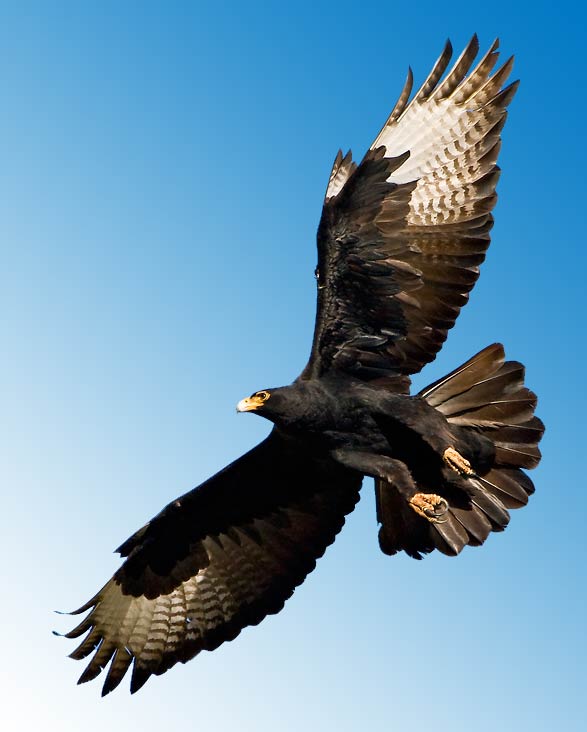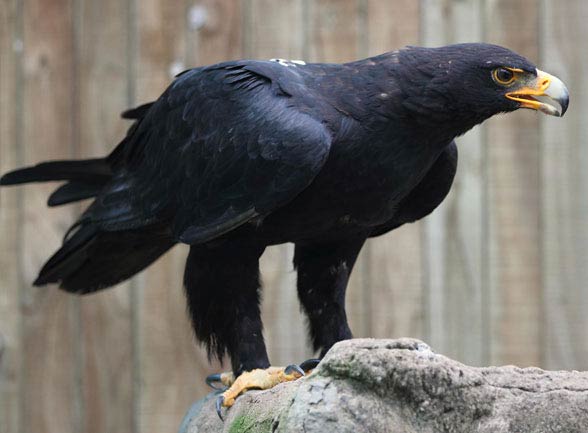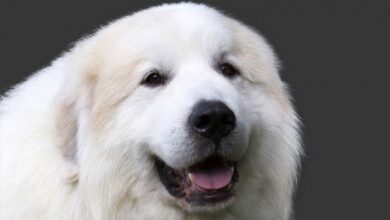Verreaux’s eagle (Aquila verreauxii) – black eagle
Supposedly the black color is optically slimming (of which the female part of our readership is perfectly aware), though it is not the only benefit of this color, as it emphasizes originality and eminence. A beautiful Accipitridae eagle – the Verreaux’s eagle, also known as the black eagle – supports the statement that blackness is never boring.
Classification
- Class: Aves
- Order: Accipitriformes
- Family: Accipitridae
- Genus: Aquila
- Species: Aquila verreauxii
- Names: Verreaux’s eagle, black eagle

Areas of occurrence
Its largest populations inhabit south and east Africa, it sometimes observed in Chad or Western Africa, as well as the Arabian Peninsula and the southern Middle East.
It is quite picky in the choice of its nesting territories, it mainly prefers the dry, rock inliers surrounded by rocky hills and mountains. It does not scorn the inliers in valleys often adjacent to savannas, acacia forests or steppes.
With all certainty it can be observed in the Marrah Mountains in Sudan (Darfur district), mountains of Somalia, Ethiopia, Uganda and Kenya. As it takes a fancy to the southern part of the continent, large numbers of these birds inhabit the Karoo region and the Cape Peninsula.

Appearance
Size
As one of the largest birds of prey and largest eagles, it reaches 75 – 96 cm (30 – 38 in) in length, males weigh from 3 to over 4 kg (6.6 – 8.8 lb), while the more massive females’ weight ranges from 3 to 5.8 kg (6.6 – 13 lb), with an average weight of around 4.1 kg (9 lb).
Wingspan ranges from 1.81 to 2.3 m (5ft 11in to 7ft 7in), the tail is 27 to 36 cm (10.7 – 14.2 in) long, and its tarsus measures between 9.5 and 11 cm (3.7 – 4.3 in).

Feathering
Adult eagles’ feathering is usually deep black, with a yellowish face, beak being grey and yellow. Intensively yellow ‘eyebrows’ and rings surrounding its eyes contrast beautifully with black feathers, whereas the irises gain dark brown colors.
It has a V-shaped snow white pattern on its back, the tail coverts are all white. The pattern its noticeable only mid-flight, for when the bird is sitting the white accents are partially covered by wings.
The bottoms of wings, especially remiges, are ornamented with black and white stripes, its beak is thick and strong, rounded head is based on a firm neck, long legs, completely covered with feathers. Adolescent eagles have a golden-russet head and neck along with a black face and breast, whereas the legs are cream-colored and the wing coverts are of a dull yellow color. Eye rings are darker than in the case of adult eagles, they develop a mature color after 5-6 years.

Sounds
It mostly is a silent species, yet when it makes any sounds, they prove to be louder than vocalizations of its close relative – the golden eagle (Aquila chrysaetos). Some sounds, used in various situations e.g. during a ‘date’ with the partner, bring young turkeys or francolins to mind. Other sounds are loud and ‘ringing’ when the aim is to fend off an intruder.
Young eagles primarily tweet gently, later on they ‘cluck’ like adult eagles.

Diet and hunting strategy
Menu
Most of the black eagles’ menu consists of the rock hyraxes (Procavia capensis) and yellow-spotted rock hyraxes (Heterohyrax brucei), which can weigh up to 5.4 kg (12 lb). In southern Africa, those mammals make 60 – 90% of Verreaux’s eagle’s menu. Besides them, it also eats birds: francolins, guineafowls, herons, as well as reptile, hares, rabbits, monkeys or even young klipspringers reaching 12 kg (26 lb) of weight
The black eagle proves to be a scavenger occasionally.

Hunting
It flies high seeking prey before diving swiftly towards it and grabbing it with its talons. It observes the territory from a high altitude – a tree or a rock. Its delicacy – hyraxes – is hunted for in teams: one eagle flies above the hyrax herd to draw attention from the other bird, which strikes suddenly, often knocking them out of the rock.
Generally it hunts for animals on the ground, yet it can sometimes hunt amongst trees.
Similar to its numerous cousins, the black eagle happens to be a thief – more specifically a kleptoparasite: it most frequently steals food from the bearded vulture (Gypaetus barbatus) and the martial eagle (Polemaetus bellicosus).

Breeding
The hatching season lasts from December to August in Sudan and in the Arabian Peninsula, from October to May in Ethiopia and Somalia, whereas in the southern parts of Africa, including Zambia – from April until November. Pairs are monogamous and can have even 5 different nests to choose from.
The mating involves various aerial stunts: rolls, somersaults, half-turns, spins, freefalling, almost completely vertical diving flights, and sudden ascents.

Nest
The nest is built from tree branches, reaches 1.8 m (5ft 11in) in diameter and about 2 m (6ft 7in) of depth (the largest black eagle’s found nest was 4 m (13ft 1in) deep). The construction is used multiple times, and is built throughout 6 to 16 weeks; during this time the eagle pair pads it with fresh leaves, locating the nest on cliffs, inliers, in caves, under rock ledges or on open rock shelves.
If birds want to spare their efforts, they may use other species’ abandoned nests like the nests of the African fish eagle (Haliaeetus vocifer).

Females lay between 1 and 3 eggs (usually 2) and incubates them for 43 – 47 days, taking extraordinary care of them and assuring their security, as the largest threat for the unhatched chicks are the mongooses, baboons, panthers and African rock pythons.
Nestlings are hatched in 3-4 day intervals, yet the older chick often kills the younger and feebler sibling – such an act of aggression may appear up to 70 days after hatching. Young eagles grow feathers after 84 – 99 days, leaving the nest soon after that, yet keeping close to their parents throughout the next 6 months, although they are able to accompany the adult eagles during hunting already after the first month.

Detailed characteristics / size
Verreaux’s eagle, black eagle (Aquila verreauxii)
- Length: 75 – 96 cm (30 – 38 in)
- Wingspan: 181 – 230 cm (5 ft 11 in to 7 ft 7 in)
- Wing chord:
- males: 56.5 – 59.5 cm (22.2 – 23.4 in)
- females: 59 – 64 cm (23 – 25 in)
- Tail length: 27.2 – 36 cm (10.7 – 14.2 in)
- Tarsus length: 9.5 – 11 cm (3.7 – 4.3 in)
- Single wing length:
- females: 59 – 64 cm
- males: 56.5 – 59.5 cm
- Body weight
- females: 3.1 – 7 kg (6.8 – 15.4 lb)
- males: 3 – 4.2 kg (6.6 – 9.3 lb)
- Lifespan: 16 years.

Verreaux’s eagle – interesting facts
- This species was originally described by Rene Primavere Lesson in 1830 in the publication by the title: ‘Centurie zoologique, ou choix d’animaux rares, nouveaux ou imparfaitement connus’ – in the description he used the name Aquila verreauxii to honor the French naturalist Jules Pierre Verreaux, who visited South Africa at the beginning of the XVII century and acquired specimen samples for the French Academy of Sciences.
- Due to its black coloration the Verreaux’s eagle may be sometimes mistaken for the Asian black eagle (Ictinaetus malayensis) – a raptor belonging to the Accipitridae family, inhabiting the Asian continent.
- Verreaux’s eagle is one of the highest specialized birds of prey in the world.
- Verreaux’s eagle is the sixth-longest and eighth heaviest eagle in the world.
- As its wings are designed for a gliding flight, the Verreaux’s eagle may fly with a speed reaching 157 km/h (98 mph).
- Adult eagles are unmistakable for any other species, as no other black bird has the same characteristic white pattern on its back.
- Cainism (fratricide) is a common phenomenon among young raptors, especially eagle chicks.
- Some experts claim that Verreaux’s eagle is a periodically migrating species, others describe its lifestyle as sedentary. Most likely the migration issue roots in young eagles’ habits, which often cross large distances seeking their own territory, adult eagles usually stay local for the rest of their lives.

Recommended
- Eagles
- Animals records
- Largest eagles Top10
- Largest birds of prey Top10
- Haast’s eagle
- Bald eagle
- Steller’s sea eagle
- Philippine eagle
- Crowned eagle
- Martial eagle
- Wedge-tailed eagle
- Bearded vulture
- Fastest animals – Top 10
- Fastest birds – Top 10
- Most venomous snakes – Top 10
- Largest sharks Top 10
- Heaviest land animals
- Largest crocodiles Top 10
- Largest whales TOP 10
- Longest snakes Top 10
- Highest (Top) flying bird – Top 10
- Largest and heaviest birds
- Largest turtles TOP 10



















Dear Sir
Your photo about flying black eagle is very good. I want to buy a copy of flying black eagle. Would you please guide how to buy lt?
Hyuntak